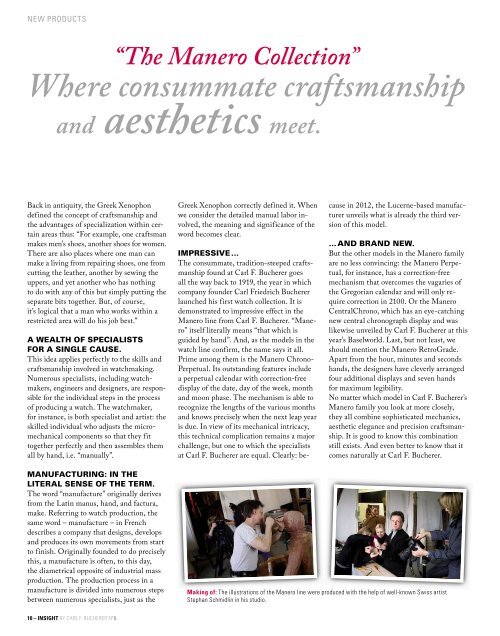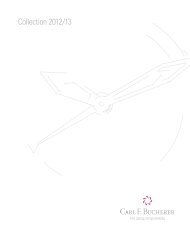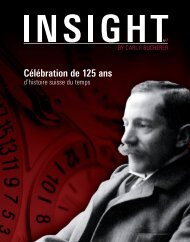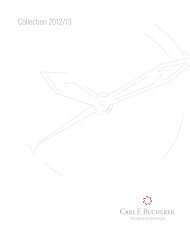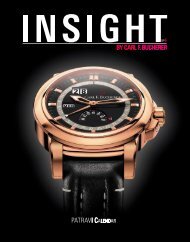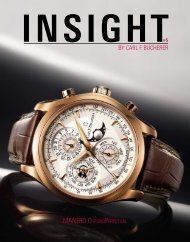Magazine “Insight†No.6 (PDF) - Carl F. Bucherer
Magazine “Insight†No.6 (PDF) - Carl F. Bucherer
Magazine “Insight†No.6 (PDF) - Carl F. Bucherer
Create successful ePaper yourself
Turn your PDF publications into a flip-book with our unique Google optimized e-Paper software.
new products<br />
“The Manero Collection”<br />
Whereconsummatecraftsmanship<br />
and aesthetics meet.<br />
Back in antiquity, the Greek Xenophon<br />
defined the concept ofcraftsmanship and<br />
the advantages ofspecialization within certain<br />
areas thus: “For example, one craftsman<br />
makes men’sshoes, anothershoes forwomen.<br />
There are also places where one man can<br />
make alivingfromrepairing shoes, onefrom<br />
cutting the leather, another bysewing the<br />
uppers, and yet another who has nothing<br />
to do with any ofthis but simply putting the<br />
separate bits together. But, ofcourse,<br />
it’s logical that aman who works within a<br />
restricted area will do his job best.”<br />
awealth ofspecialists<br />
for asingle cause.<br />
This idea applies perfectly to the skills and<br />
craftsmanship involved in watchmaking.<br />
Numerous specialists, including watchmakers,<br />
engineers and designers, are responsible<br />
for the individual steps in the process<br />
of producing awatch. The watchmaker,<br />
for instance, isboth specialist and artist: the<br />
skilled individual who adjusts the micromechanical<br />
components sothat they fit<br />
together perfectly and then assembles them<br />
all by hand, i.e. “manually”.<br />
Manufacturing: inthe<br />
literal sense of the terM.<br />
The word “manufacture” originally derives<br />
from the Latin manus, hand, and factura,<br />
make. Referring to watch production, the<br />
same word –manufacture –inFrench<br />
describes acompany that designs, develops<br />
and produces its own movements from start<br />
to finish. Originally founded to do precisely<br />
this, amanufacture is often, to this day,<br />
the diametrical opposite ofindustrial mass<br />
production. The production process in a<br />
manufacture is divided into numerous steps<br />
between numerous specialists, just as the<br />
10 –InsIght by <strong>Carl</strong> F. buCherer Nº6<br />
Greek Xenophon correctly defined it. When<br />
we consider the detailed manual labor involved,<br />
the meaning and significance of the<br />
word becomes clear.<br />
iMpressive…<br />
The consummate, tradition-steeped craftsmanship<br />
found at <strong>Carl</strong> F. <strong>Bucherer</strong> goes<br />
all the way back to 1919, the year inwhich<br />
company founder <strong>Carl</strong> Friedrich <strong>Bucherer</strong><br />
launched his first watch collection. Itis<br />
demonstrated toimpressive effect inthe<br />
Manero line from <strong>Carl</strong> F. <strong>Bucherer</strong>. “Manero”<br />
itself literally means “that which is<br />
guided by hand”. And, as the models inthe<br />
watch line confirm, the name says it all.<br />
Prime among them is the Manero Chrono-<br />
Perpetual. Its outstanding features include<br />
aperpetual calendar with correction-free<br />
display ofthe date, day of the week, month<br />
and moon phase. The mechanism is able to<br />
recognize the lengths ofthe various months<br />
and knows precisely when the next leap year<br />
is due. In view of its mechanical intricacy,<br />
this technical complication remains amajor<br />
challenge, but one towhich the specialists<br />
at <strong>Carl</strong> F. <strong>Bucherer</strong> are equal. Clearly: be-<br />
cause in 2012, the Lucerne-based manufacturer<br />
unveils what isalready the third version<br />
of this model.<br />
…anD branD new.<br />
But the other models inthe Manero family<br />
are noless convincing: the Manero Perpetual,<br />
for instance, has acorrection-free<br />
mechanism that overcomes the vagaries of<br />
the Gregorian calendar and will only require<br />
correction in 2100. Orthe Manero<br />
CentralChrono, which has an eye-catching<br />
new central chronograph display and was<br />
likewise unveiled by <strong>Carl</strong> F. <strong>Bucherer</strong> at this<br />
year’s Baselworld. Last, but not least, we<br />
should mention the Manero RetroGrade.<br />
Apart from the hour, minutes and seconds<br />
hands, the designers have cleverly arranged<br />
four additional displays and seven hands<br />
for maximum legibility.<br />
No matter whichmodel in <strong>Carl</strong> F. <strong>Bucherer</strong>’s<br />
Manero family you look atmore closely,<br />
they all combine sophisticated mechanics,<br />
aesthetic elegance and precision craftsmanship.<br />
It is good to know this combination<br />
still exists. And even better toknow that it<br />
comes naturally at<strong>Carl</strong> F.<strong>Bucherer</strong>.<br />
Making of: The illustrations of the Manero line were produced with the help ofwell-known Swiss artist<br />
Stephan Schmidlin inhis studio.


